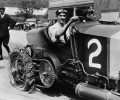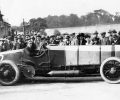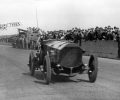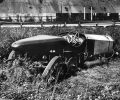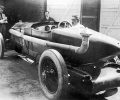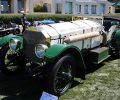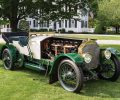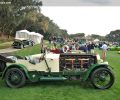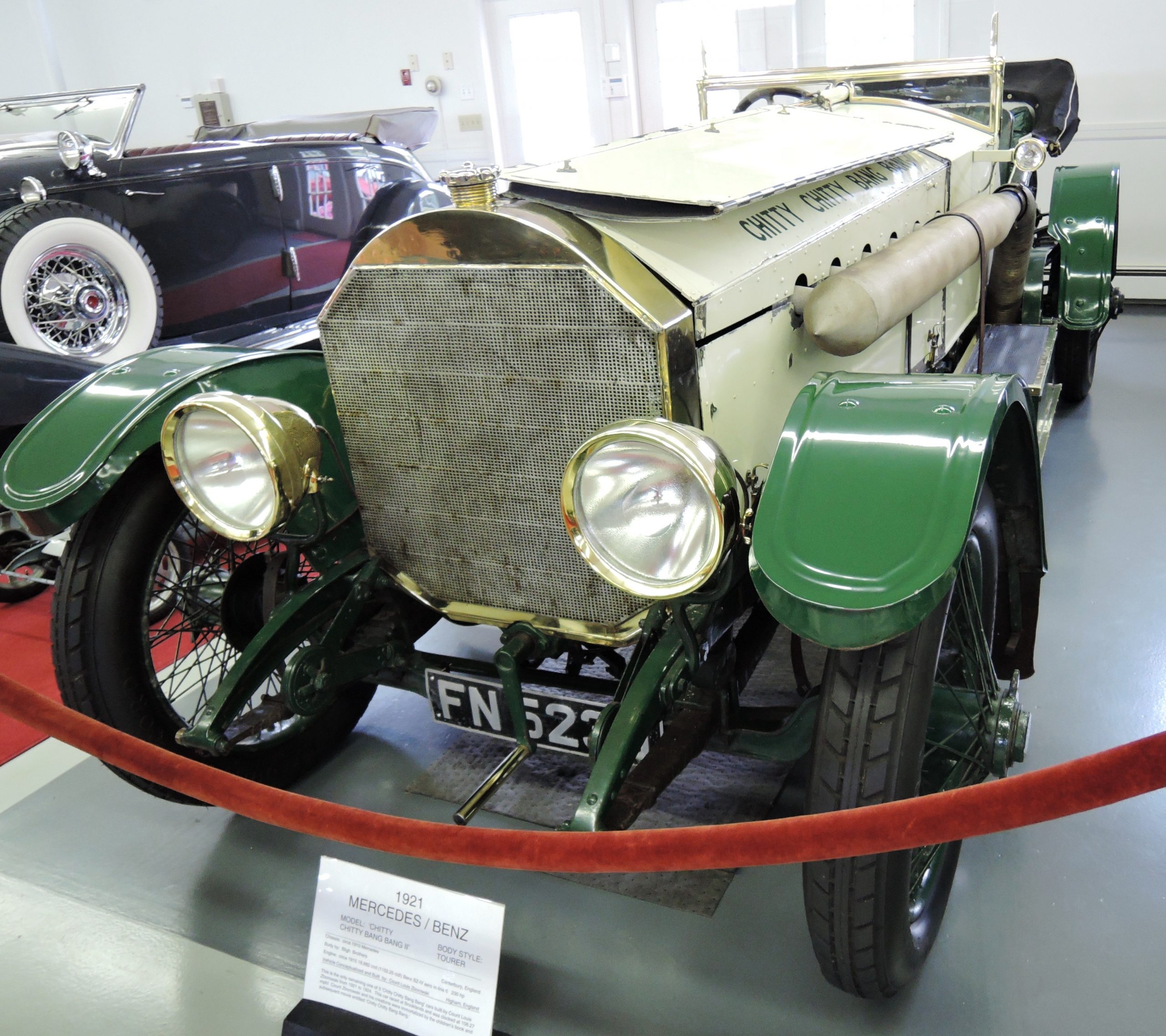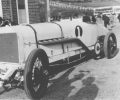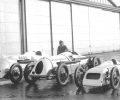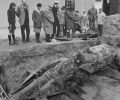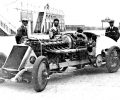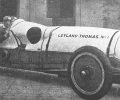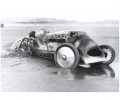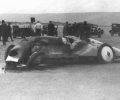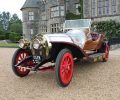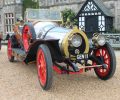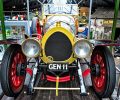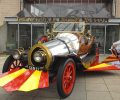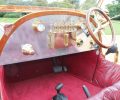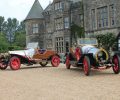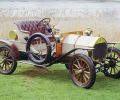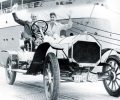CHITTY BANG BANG
How many Chittys were built. Count Louis Zborowski designed and built four racing cars in the stables at Higham Park from 1921-1924, The 4th was not fully developed by the time of Zborowski’s death in November 1924. Count Zborowski’s exploits inspired Ian Fleming’s Chitty Chitty Bang Bang story. There were six original Chitty Chitty Bang Bang were built for the 1968 film – two were racers and four were touring cars. One was fitted with a hovercraft skirt to skim over the water, while another was able to spread its wings when required. In the opening credits of the film, you can see tributes to the original Chitty Bang Bang racing history. see video at bottom of page
Racing
Zborowski’s career as an amateur racing driver encompassed a wide experience of marques and events. In 1921 Zborowski was to drive one of the 1921 Grand Prix Sunbeams representing Britain at Le Mans but this did not transpire and instead he raced the car at the International Shelsley Walsh – England’s foremost Speed Hill-Climb. He was an early patron of Aston Martin, and raced for them at Brooklands and in the French Grand Prix. In the 1923 raced at the 11th International 500-Mile Sweepstakes Race was held at the Indianapolis Motor Speedway. Zborowski drove a Bugatti and finish #24. He drove in the Italian Grand Prix at Monza in a single-seat “American Miller 122”. Zborowski joined the Mercedes team in 1924 but died in one of their cars, after hitting a tree during the Italian Grand Prix at Monza. He was just 29 years old.
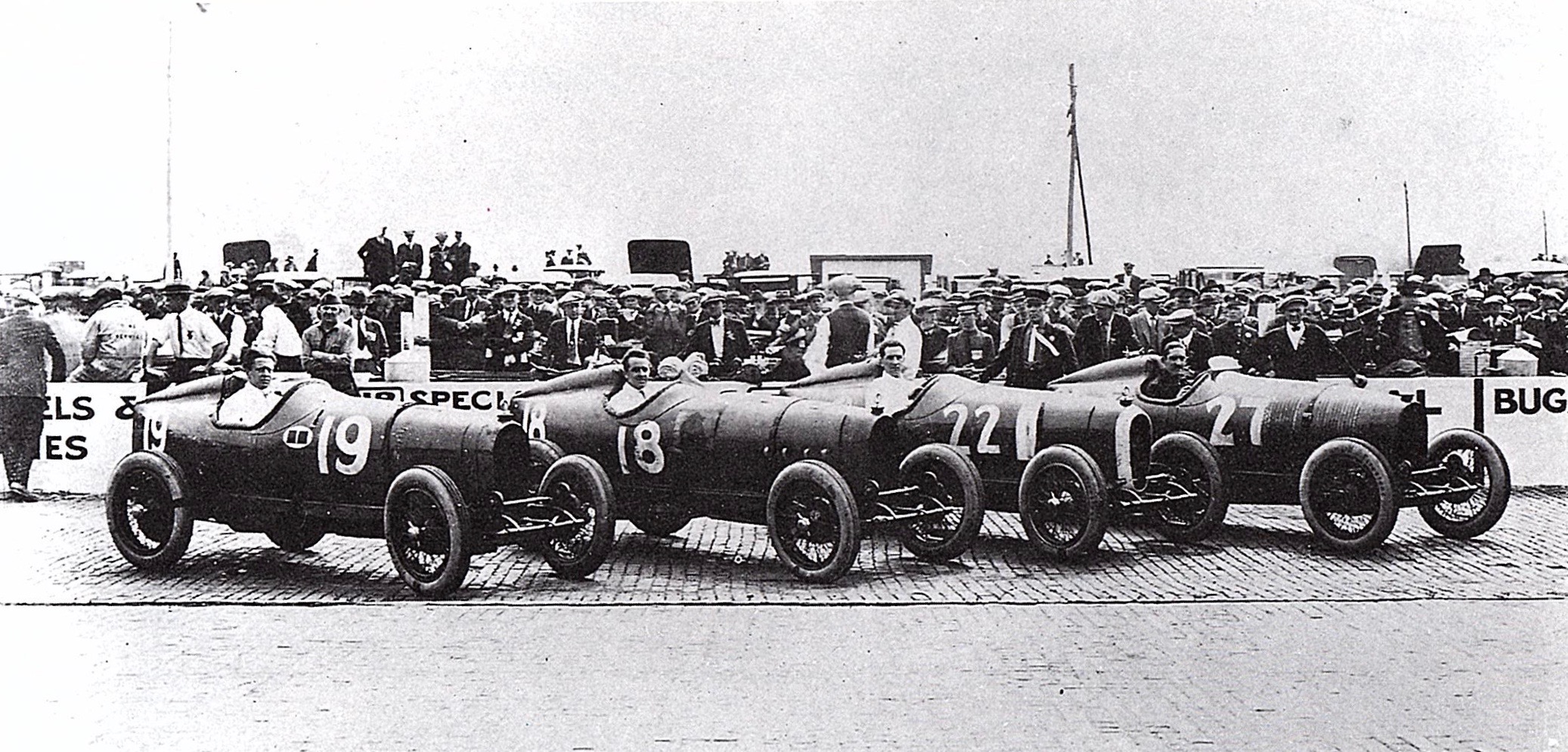
Chitty Bang Bang 1
Zborowski designed and built four of his own racing cars in the stables at Higham Park from 1921-1924, assisted by his engineer and co-driver Captain Clive Gallop, who was later racing engineer to the “Bentley Boys”. Chitty 1 was powered by a 23,093 cc six-cylinder Maybach aero engine and called “Chitty Bang Bang”. It achieve celebrity status at the Brooklands race track in 1921 by winning two races in her debut appearance, reaching speeds of 100.75 miles an hour in the Brooklands Short Handicap.
In order to get significant ground clearance the original maybach oil-sump had to be removed, so a system of dry-sump lubrication was contrived, with a big oil reservoir slung alongside the chassis frame on the off-side. In the fashion of those times this was giving a pointed prow for good air penetration, in spite of the enormous drag of the big radiator and primitive bodywork.
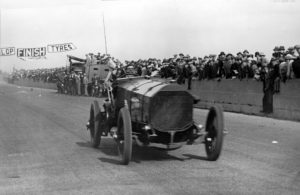
Chitty was in the nature of an experiment and it was at first giving a crude four-seater body, which was knocked up by Blythe Bros. of Canterbury, a very long established coach building firm in which the Count had a financial interest and whose trade plates he apparently used when taking his car out on test. Chitty was an immediate success and was great fun on the road, providing it s negligible breaking power was kept in mind, and it was not called upon to negotiate twisting sections of the local terrain.
At Brooklands, The great car was a sensation. Zborowski used to turn up in the company with his friend major Jack Cooper, Miles and mechanic Wigginsworth, all of them wearing loud check caps imported from Palm Beach. To see them starting Chitty with the aid of a half-axle from a B.E. Aeroplane, the half compression device and someone furiously winding the dashboard starting-magneto was a site no Brooklsnd’s habitue cared to miss.
The press helped the drama along by describing Chitty as of 600 horsepower and billing it as a rival to the big Sunbeam, which they endowed with at least 450 horsepower. For all his flamboyance, Zborowski was cautious. He knew that much would be expected of his 23-litre home-built car and that it if it failed as a race car he could become a laughing stock. He did not expect the handicappers to treat him kindly. So the ugly body set off by crude exhaust pipe with a right angle bend in it was a foil to any ambitions he had for the car.
Paint gray, Chitty was entered for the Easter 1921 brooklands meeting. Although the chassis had been strengthened by bracing rods and flitch plates, handling was none too good and it was found advisable to carry 7 cwt. of sand in the back of the body to keep the back wheels in contact with the cement.
Chitty went out for the first race on that Easter Monday at Brooklands on 28th March 1921, giving Birkin’s D.F.P. 78 seconds start and itself leaving the line 4 seconds ahead of Andre Boillot in the 4.9 litre six-cylinder Sunbeam. Zborowski was faster on starting-start lap than the Frenchman, and although the Sunbeam made up a little on the flying lap it could not catch the aero-engine car which lapped at 108.15 mph. and won its first race, this 23rd 100 mph Short Handicap, at 100 mph. The bookies took 6 to 4 on Zborowski, 4 to 1 the field.
In gallery: How Chitty 1 finished up after the accident in practice at Brooklands in 1922. It burst a tire, hit the parapet of the track, slid down the home banking, demolished a wooden hut, cutting off the fingers of an official as it did so, tore off its front axle, discarded its mechanic and ended up as shown, the off-side tire having left the rim. Zborowski still in the driving seat was uninjured and Chitty 1 was rebuilt.
Chitty Bang Bang 2
Zborowski began building Chitty 2 in the summer of 1921. This model was similar to the first Chitty but had a shorter wheelbase, an early Mercedes chassis and an 18.8 litre Benz BZ series aero-engine. This car was never as successful, It failed to make its mark at Brooklands but took part in several races. In January 1922, Zborowski, his wife Vi Zborowski, Pixi Marix (who was identified the young girl cited in Zborowski’s divorce case) and Colonel Clive Gallop together with a couple of mechanics drove Chitty Bang Bang 2 and 3 through France and then across the Mediterranean into the Sahara Desert. Chitty Bang Bang 3 followed as a “cargo waggon”. Colonel Reginald Clive Gallop was an engineer, racing driver and First World War pilot. He was one of the team which developed their first engine for Bentley Motors. (Born: February 4, 1892, Cairo, Egypt. Died: September 7, 1960, Leatherhead, United Kingdom)
Chitty Bang Bang 2 is the only one of the three original ‘Chitty Bang Bang’ remaining. Chitty 2 was sold to a private party. It remained in their care until being purchased by the English motor trader ‘Bunty’ Scott-Moncrief who found another buyer for the vehicle. Years later the car was sold to the Ellenville Motor Museum in Ellenville, NY, which has since closed. The vehicles next owner was the Crawford Auto Collection of Cleveland, Ohio. It is now in the collection of a private individual.
Chitty Bang Bang 3
 Referred to as the White Mercedes. It was based on a modified Mercedes chassis with a 160 hp (120 kW) Mercedes single-overhead-camshaft six-cylinder aero engine, tuned to produce 180 hp (130 kW). The car achieved some success and recorded a lap of 112.68 mph (181.34 km/h) at Brooklands.
Referred to as the White Mercedes. It was based on a modified Mercedes chassis with a 160 hp (120 kW) Mercedes single-overhead-camshaft six-cylinder aero engine, tuned to produce 180 hp (130 kW). The car achieved some success and recorded a lap of 112.68 mph (181.34 km/h) at Brooklands.
Louis Zborowski later used it as his personal transport, and drove it to Stuttgart when he negotiated to join the Mercedes racing team.
Chitty Bang Bang 4

Chitty Bang Bang 4 was also built at Higham Park with a huge 27-litre aero engine, This car was called the “Higham Special” and later “Babs”. It was Louis Zborowski’s largest open-wheel, front-engined racing car. Using a 450 hp (340 kW) V12 Liberty aero engine of 27 litres capacity, with a gearbox and external chain-drive from a pre-war Blitzen Benz, it was the largest capacity racing car ever to run at Brooklands. Still not fully developed by the time of Zborowski’s death in November 1924, it was purchased from his estate by J.G. Parry-Thomas for the sum of £125 Pound sterling.
Parry-Thomas changed the car’s name to Babs. Babs was fitted with yet another body, partially enclosing the drive and rear wheels by fairings, a rebuilt four Zenith carburettors and his own design of pistons. In April 1926, Parry-Thomas used the car to win the Land speed record at 171.02 mph (273.6 km/h).
On March 3, 1927 with an improved Babs, Parry-Thomas returned to Pendine to regain his own world land speed record that had been broken just weeks earlier by Malcolm Campbell on the same beach. On February 4th. Campbell set the land speed record (in an average of two runs) at 174.883 mph (281.447 km/h)
Parry-Thomas has an exceptional first run, reported at 180mph (289.682 km/h), however a spectator walked through the timing beam unfortunately voiding this run. Parry-Thomas went for a second attempt and during his return run, he lost control and the car flipped killing him. As a mark of respect, following the inquest, Babs was buried in the dunes at Pendine Sands.
In 1967 Owen Wyn Owen, who was a automobile restorer, decided to excavate and restore Babs. The site of the burial was identified from old photographs, once found and granted permission for the excavation, Babs was exhumed in 1969.
At the time of the accident in 1927 it was thought that the right-hand chain had broken and had hit Thomas, causing a fatal head injury as the car was rolling. During the subsequent restoration of the car, it was found that this could not have been the case and that it was more likely that Thomas had been killed as a result of the injuries he sustained while the car rolled and slid along the beach.
The 15 year restoration work took place in Owen’s garage in Capel Curig UK. Babs is now displayed in the Pendine Museum of Speed during the summer months and Brooklands Museum during the winter.
Parry-Thomas
 John Godfrey Parry-Thomas (6 April 1884 – 3 March 1927) was a Welsh engineer and motor-racing driver who at one time held the land speed record. He was the first driver to be killed in pursuit of the land speed record.
John Godfrey Parry-Thomas (6 April 1884 – 3 March 1927) was a Welsh engineer and motor-racing driver who at one time held the land speed record. He was the first driver to be killed in pursuit of the land speed record.
Parry-Thomas became chief engineer at Leyland Motors, a company whose main products were commercial vehicles. He filed for and received a number of patents, in the fields of electrical and automotive engineering. After the First World War he and his assistant Reid Railton designed the Leyland Eight luxury motor car, which was intended to compete with Rolls-Royce. His experience of driving this car around Brooklands in 1920 persuaded him to give up his career with Leyland to become a full-time motor-racing driver and engineer.
In partnership with another engineer, Ken Thomson, Parry-Thomas started Thomas Inventions Development Co., a motor-racing engineering and car-building firm, based within the Brooklands race track.
From 1923 he lived at Brooklands in a bungalow. It was an ascetic life, shared only with two Alsatian dogs and his cars. After his death, this company became Thomson & Taylor. They were active between the wars and built several of the famous land speed record breaking cars of the day such as Malcolm Campbell’s Blue Bird.
Parry-Thomas achieved some success on the circuit, winning 38 races in five seasons and setting numerous records. Parry-Thomas was buried in St Mary’s Churchyard in Byfleet, Surrey, close to the Brooklands Circuit.
Pendine Sands
Pendine Sands has long been the site of motor racing due to the smooth sand that Pendine Sands provided it was deemed the best place in Britain to attempt Land Speed record breaking in the late 1920s. Pendine Sands is best known where Malcolm Campbell and J. G. Parry-Thomas set the world land speed record five times between 1924 and 1927.
Pendine Sands is 7 miles (11 km) of beach on the shores of Carmarthen Bay on the south coast of Wales. It stretches west to east from Gilman Point to Laugharne Sands. A recent ban on vehicles driving on the hallowed sands has been reversed. The areas you can drive on are limited now.
The Pendine Museum of Speed is dedicated to the use of Pendine Sands for land speed record attempts. It was opened in 1996 in the village of Pendine, on the south coast of Wales, and is owned and run by Carmarthenshire County Council. The museum received 33,522 visitors in 2009.
The Brooklands Museum is a motoring and aviation museum occupying part of the former Brooklands motor-racing track in Weybridge, Surrey, England.
Count Louis Zborowski – Life & Legacy
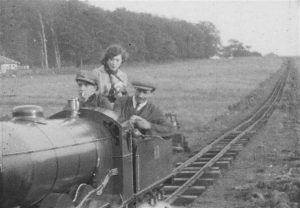 Zborowski was a railway enthusiast and a 15 in (381 mm) gauge railway circuit, the Higham Railway, was built around his estate in Kent. This line was part of the inspiration behind the joint decision by Zborowski and his racing friend Captain J.E.P. Howey to construct a long-distance passenger-carrying railway line in the same gauge. Many locations were investigated, but this eventually led to the founding of the 14-mile (23 km) long Romney, Hythe and Dymchurch Railway in Kent, which remains a popular tourist attraction and means of local transport. Zborowski ordered a steam locomotive from Bassett-Lowke, which ran on the Higham Railway in 1924. The locomotive was purchased by the Fairbourne Railway in Wales following the Count’s death and named “Count Louis” in his honour. The locomotive remained at the Fairbourne until 1988. Zborowski also ordered the first locomotives for the Romney, Hythe and Dymchurch Railway from Davey Paxman & Co. of Essex. He never saw the Romney, Hythe and Dymchurch Railway in action because of his untimely death but the project was continued by Capt Howey.
Zborowski was a railway enthusiast and a 15 in (381 mm) gauge railway circuit, the Higham Railway, was built around his estate in Kent. This line was part of the inspiration behind the joint decision by Zborowski and his racing friend Captain J.E.P. Howey to construct a long-distance passenger-carrying railway line in the same gauge. Many locations were investigated, but this eventually led to the founding of the 14-mile (23 km) long Romney, Hythe and Dymchurch Railway in Kent, which remains a popular tourist attraction and means of local transport. Zborowski ordered a steam locomotive from Bassett-Lowke, which ran on the Higham Railway in 1924. The locomotive was purchased by the Fairbourne Railway in Wales following the Count’s death and named “Count Louis” in his honour. The locomotive remained at the Fairbourne until 1988. Zborowski also ordered the first locomotives for the Romney, Hythe and Dymchurch Railway from Davey Paxman & Co. of Essex. He never saw the Romney, Hythe and Dymchurch Railway in action because of his untimely death but the project was continued by Capt Howey.
Following his death, villagers in Patrixbourne began to see visions of the a ghostly Chitty Chitty Bang Bang thundering through the lanes. Author Ian Fleming had long been a fan of Count Zborowski, first watching in awe as a boy when he raced at Brooklands. Later when his friend Walter Whigham acquired Higham Park, re-naming it Highland Court, he visited the estate and learned more about the Count’s exploits which inspired him to write the story. The children’s book by Ian Fleming, Chitty Chitty Bang Bang, and the subsequent musical film, were inspired by the romance of Zborowski’s exploits. Fleming had watched Zborowski race at Brooklands as a school boy.
Car manufacturer Arrinera Racing explains history of Count Louis Zborowski
The Movie
Chitty Chitty Bang Bang (1968)
Opening at the 1907 British Grand Prix, the Chitty Chitty Bang Bang #3 took first place. This continued at the 1908 Grand Prix De France with a doppelgänger Count Louis Zborowski exiting Chitty to collect his first place trophy. Next was the 1908 Grand Prix Deutschland with another 1st place win. During the 1909 British Grand Prix, the number 3 cars swerved to miss a young girl who ran after her dog across the path of the racing car, the car went of the track, crashed and burned, ending Chitty Chitty Bang Bang’s racing career. The race car was sold off for scrap metal.
The car eventually ends up in an old garage in rural England, where two children have grown fond of it. However, a man in the junkyard intends to buy the car for scrap, The children implore their father, an eccentric professor that invents wacky machinery to buy the car. After he sees and recognises the famous race car, he eventually promises the children that he will save the car. He then turns the broken-down Grand Prix car into a fancy vehicle for his children, and then they go off on a magical fantasy adventures.
Although the story beginning is not historically correct, it is however a fitting tributes to Count Louis Zborowski and the original Chitty Bang Bangs
Events
BEAULIEU LAUNCHES CHITTY CHITTY BANG BANG 50 YEARS EXHIBITION
To celebrate the golden half century of one of the world’s favourite films Beaulieu is to launch its Chitty Chitty Bang Bang 50 years exhibition which can be seen in the National Motor Museum from October 20. 2018
The exhibition will tell the story of Chitty as the star of the fantasmagorical family adventure and feature an original screen Chitty Chitty Bang Bang and the Humber 8hp driven by Truly Scrumptious in the much-loved musical film.
Coggins’ Garage will be recreated in the museum to house the amazingly inventive machines of Rowland Emett seen in the film, including the Humbug Major Sweet Machine, Clockwork Lullabye, Little Dragon Carpet Sweeper and Hot Air Rocking Chair.
Standing outside will be a full-size replica of Grandpa Potts’ hut, recreated using the original 50-year-old technical drawings from the archive of EON Productions. The actual Spy Phone prop used in the film will be on show alongside.
Costumes as seen in the film will include those of the infamous Child Catcher and Sally Anne Howes’ life-size music box dolldress which she wore while dancing with Dick Van Dyke for Baron Bomburst’s birthday surprise.
A timeline wall will chart the Chitty story from its beginnings – as James Bond creator Ian Fleming’s inspirational book about the magical flying car – to Cubby Broccoli’s unique interpretation on film. Fleming was inspired by the real-life exploits of racing driver Count Louis Zborowski who designed and built four aero-engined racing cars that were named Chitty Bang Bang because of the sound they made while standing idle. The exhaust and leather bonnet strapfrom the Count’s original Mercedes Chitty will be on display as part of his legacy.
The cloud-shaped wall will also feature first edition copies of Fleming’s book which he wrote for his son Caspar and was published posthumously in 1964, alongside producer Cubby Broccoli’sprogramme from the Royal World Premiere of the Chitty Chitty Bang Bang film in 1968. Weird and wonderful Chitty memorabilia includes signatures of the star-studded cast, pedal and Corgi cars, comics, computer games, pop-up books and even lunch boxes made to celebrate the children’s favourite film.
Never exhibited before original film concept art by Sir Ken Adam, storyboard watercolour artwork by Robert Laing and technical drawings by Peter Lamont will be on display, along with the solid silver Chitty model bought for producer Cubby Broccoli by his wife Dana.
Outside in the grounds, visitors to Beaulieu can see a stunning Chitty Chitty Bang Bang reconstruction being driven around the attraction – you may even be lucky enough to go for a ride!
Thanks to Fleming’s brilliant story about the beautiful, magical car and Roald Dahl’s screenplay adaptation, Chitty Chitty Bang Bang remains as popular today as it ever has been.
Chitty Chitty Bang Bang 50 years can be seen as part of the general admission to Beaulieu, which includes entrance to the National Motor Museum, World of Top Gear, On Screen Cars, the ancestral Montagu family home of Palace House, 13thcentury Beaulieu Abbey and the grounds and gardens. To buy tickets in advance online or for more information see www.beaulieu.co.uk or call 01590 612345.
Find us on Twitter @Beaulieu_Hants, Facebook at /nationalmotormuseum or Instagram @national_motor_museum and join the conversation with #Chitty50years.
- Six original Chittys were built for the film by Alan Mann of Alan Mann Racing – two were racers and four were touring cars. One was fitted with a hovercraft skirt to skim over the water, while another was able to spread its wings when required.
- Beaulieu’s Chitty is owned by EON Productions and its after-film adventure took it to Australia, before being rediscovered by a film car enthusiast and brought back to the UK in 1987. It was used for the hovercraft and some ‘blue screen’ special effect flying sequences and therefore is mainly made of lighter weight aluminium to make it easier to manoeuvre during filming.
- It has since taken part in the Macy’s Thanksgiving Day Parade in New York in 2004, visited the Queen for her Birthday Garden Party in 2006, flew to Singapore to promote Chitty Chitty Bang Bang The Musical in 2007 and had a day on London’s South Bank celebrating Cubby Broccoli’s centenary in 2009.
- The Chitty Chitty Bang Bang film, produced by Albert R. ‘Cubby’ Broccoli of James Bond fame, was Oscar nominated for its musical score and featured a host of stars including Dick Van Dyke, Sally Ann Howes, Lionel Jeffries, Benny Hill and Barbara Windsor.

